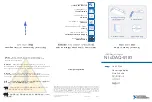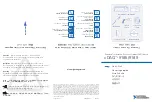
1-2
Cisco ASA Series CLI Configuration Guide
Chapter 1 Configuring the Identity Firewall
Information About the Identity Firewall
The Identity Firewall integrates with Microsoft Active Directory in conjunction with an external Active
Directory (AD) Agent that provides the actual identity mapping. The ASA uses Windows Active
Directory as the source to retrieve the current user identity information for specific IP addresses and
allows transparent authentication for Active Directory users.
Identity-based firewall services enhance the existing access control and security policy mechanisms by
allowing users or groups to be specified in place of source IP addresses. Identity-based security policies
can be interleaved without restriction between traditional IP address based rules.
The key benefits of the Identity Firewall include:
•
Decoupling network topology from security policies
•
Simplifying the creation of security policies
•
Providing the ability to easily identify user activities on network resources
•
Simplify user activity monitoring
Architecture for Identity Firewall Deployments
The Identity Firewall integrates with Window Active Directory in conjunction with an external Active
Directory (AD) Agent that provides the actual identity mapping.
The identity firewall consists of three components:
•
ASA
•
Microsoft Active Directory
Though Active Directory is part of the Identity Firewall on the ASA, they are managed by Active
Directory administrators. The reliability and accuracy of the data depends on data in Active
Directory.
Supported versions include Windows Server 2003, Windows Server 2008, and Windows Server
2008 R2 servers.
•
Active Directory (AD) Agent
The AD Agent runs on a Windows server. Supported Windows servers include Windows 2003,
Windows 2008, and Windows 2008 R2.
Note
Windows 2003 R2 is not supported for the AD Agent server.
Summary of Contents for 5505 - ASA Firewall Edition Bundle
Page 28: ...Glossary GL 24 Cisco ASA Series CLI Configuration Guide ...
Page 61: ...P A R T 1 Getting Started with the ASA ...
Page 62: ......
Page 219: ...P A R T 2 Configuring High Availability and Scalability ...
Page 220: ......
Page 403: ...P A R T 2 Configuring Interfaces ...
Page 404: ......
Page 499: ...P A R T 2 Configuring Basic Settings ...
Page 500: ......
Page 533: ...P A R T 2 Configuring Objects and Access Lists ...
Page 534: ......
Page 601: ...P A R T 2 Configuring IP Routing ...
Page 602: ......
Page 745: ...P A R T 2 Configuring Network Address Translation ...
Page 746: ......
Page 845: ...P A R T 2 Configuring AAA Servers and the Local Database ...
Page 846: ......
Page 981: ...P A R T 2 Configuring Access Control ...
Page 982: ......
Page 1061: ...P A R T 2 Configuring Service Policies Using the Modular Policy Framework ...
Page 1062: ......
Page 1093: ...P A R T 2 Configuring Application Inspection ...
Page 1094: ......
Page 1191: ...P A R T 2 Configuring Unified Communications ...
Page 1192: ......
Page 1333: ...P A R T 2 Configuring Connection Settings and QoS ...
Page 1334: ......
Page 1379: ...P A R T 2 Configuring Advanced Network Protection ...
Page 1380: ......
Page 1475: ...P A R T 2 Configuring Modules ...
Page 1476: ......
Page 1549: ...P A R T 2 Configuring VPN ...
Page 1550: ......
Page 1965: ...P A R T 2 Configuring Logging SNMP and Smart Call Home ...
Page 1966: ......
Page 2059: ...P A R T 2 System Administration ...
Page 2060: ......
Page 2098: ...1 8 Cisco ASA Series CLI Configuration Guide Chapter 1 Troubleshooting Viewing the Coredump ...
Page 2099: ...P A R T 2 Reference ...
Page 2100: ......














































